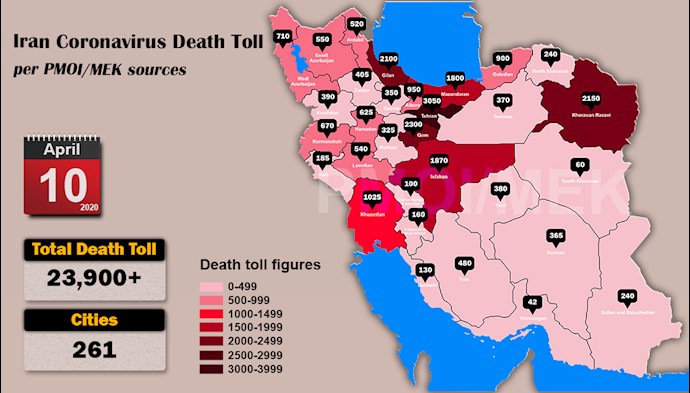Reporting by PMOI/MEK
Iran, April 10, 2020—More than 23,900 people have died of the novel coronavirus (COVID-19) in 261 cities across all of Iran’s 31 provinces, according to the Iranian opposition People's Mojahedin Organization of Iran (PMOI/MEK) based on reports tallied up to Friday afternoon local time, April 10. The official death count declared by the regime is 4,232, less than a fifth of the real figure.
The death toll in various provinces include: 2,150 in Khorasan Razavi, 1,870 in Isfahan, 1,800 in Mazandaran, 1,025 in Khuzestan, 900 in Golestan, 950 in Alborz, 710 in Western Azerbaijan, 550 in Eastern Azerbaijan, 625 in Hamedan, 520 in Ardebil, 405 in Zanjan, 380 in Yazd, 325 in Markazi, 185 in Ilam, 160 in Kohgiluyeh and Boyer-Ahmad, 130 in Bushehr, and 60 in Southern Khorasan. This is in addition to cases registered in other provinces.

Over 23,900 dead of coronavirus (COVID-19) in Iran
In Tehran’s hospitals, the patients are so numerous that some are lying in hallways and aren't receiving care or medicine. The city’s emergency services are not sufficient and are refraining from transferring many patients to hospitals. Respiratory devices, including ventilators, are very scarce and patients are charged expensively for using them (sometimes up to 200 million rials, approx. $1,250). Nurses and medical workers are faced with a shortage of masks, gloves, and disinfectants. These items are also scarce in markets and are being sold at very high prices. The government’s screening plan has ended up being nothing more than a publicity stunt and has no scientific basis.
One of the workers of Mashhad’s Shariati hospital said, “Anything the government declares, multiply it by ten. Due to the security presence, it’s not possible to report the figures.” The same source added, “Mashhad doesn’t have test kits. The test samples were sent to Tehran. The results will return in seven days and by then many of the patients will have died.”
Ghorbanali Valizadeh Boura, MP from Tehran, told the state-run IRNA news agency on Thursday, “Today, the number of coronavirus patients that have entered hospitals is greater than those who were discharged, which is very concerning.”
A large number of soldiers are infected with coronavirus in many of the regime’s military bases, including the cities of Birjand, Ghouchan, Bojnourd and Torbate Jam. However, officials are keeping a lid on these reports to prevent soldiers from fleeing their bases.
The spread of COVID-19 in the northern and western regions of Gilan Province, northern Iran, is described as atrocious. Two hundred people have died in the city of Talesh alone while another 50 have lost their lives in the city of Astara. A large number of people are also dying of coronavirus in various villages and there are no numbers from these areas.
While Iranian regime Supreme Leader Ali Khamenei and President Hassan Rouhani intend to send people back to work on Saturday, April 11, Alireza Zali, head of the Covid-19 Control Task Force in the Iranian capital of Tehran, voiced concerns in this regard. “Around 86.4 percent of people support imposing more preventive measures to guarantee the containment of this illness,” he said.
Rouhani ridiculously justifies the killing of millions of people in the coronavirus crisis#Iran#COVIDー19 https://t.co/G2Y04fvZeo
— People's Mojahedin Organization of Iran (PMOI/MEK) (@Mojahedineng) April 9, 2020
“The government does not believe in quarantine measures. The Majlis (parliament) attempted to pass an urgent blueprinting to shut down the country for a month,” said Majlis member Tayebeh Siavoshi.
However, the entire plan was taken out of the agenda in a strange fashion to decrease supervision over the government to a minimum… Many of the people that are workers or employees are forced to commute in the streets on a daily basis as they go to work. This is truly very concerning,” she added.
A poll run by a state-run outlet acknowledged that 75 percent of the Iranian population prefer to have schools and stores closed than returning to work. (ISNA news agency – April 9)
Ebrahim Raisi, head of the regime’s so-called judiciary, warned his apparatus to “follow up and prevent disruptions.” This sheds further light on the Iranian regime’s main concern not being to overcome the coronavirus and saving people’s lives, but to prevent any possible threat to their rule.
“One of the main issues on the agenda of the Supreme Council on Preventing Crimes is focusing on the post-coronavirus stage and evaluating the various possibilities. We also have post-coronavirus social, economic and cultural issues. As long as there is social unrest, all of our apparatuses have a responsibility to prevent these events into becoming crimes. When this transition takes place, naturally the judiciary steps in to follow up. This really needs to take place as preventive measures and the post-coronavirus subject is a very important matter. All aspects need to be evaluated and placed on our agenda, discussed as soon as possible and hopefully we will not be passive in this regard. We need to be able to actively address our post-coronavirus issues,” Raisi said.
Iran coronavirus outbreak death toll interactive map




